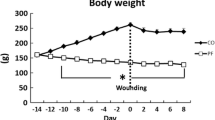Abstract
Protein malnutrition is largely associated with a delay or failure of the healing process. However, the effect of dietary protein quality on wound healing is largely unknown. This study aimed to reveal the effect of dietary protein quality on wound healing and elucidate the regulatory mechanisms in a rat model of full-thickness cutaneous wounds. Rats were fed a normal diet for a week, and then they were divided into three groups that were fed the following diet for the experimental period: casein diet, gluten diet and gluten + lysine diet. The gluten diet significantly decreased body weight and wound healing compared with the casein diet, but this effect was reversed by supplementation with lysine. The numbers of leukocytes were significantly higher in the skin of the gluten group than those in the casein group. The wounded skin tissues of the gluten group showed lower amounts of collagen deposition compared with that in the casein group. Our results also showed that both matrix metalloproteinase (MMP) 2 activity and MMP14 mRNA levels were significantly increased in the skin of the gluten group, compared with the casein group. In summary, this study suggests low-quality protein diets have negative effects on wound healing via modulation of MMP2 activity in rats.





Similar content being viewed by others
References
Bayham BE, Greenway FL, Johnson WD, Dhurandhar NV (2014) A randomized trial to manipulate the quality instead of quantity of dietary proteins to influence the markers of satiety. J Diabetes Complicat 28:547–552
Bigg HF, Rowan AD, Barker MD, Cawston TE (2007) Activity of matrix metalloproteinase-9 against native collagen types I and III. FEBS J 274:1246–1255
Caley MP, Martins VL, O’Toole EA (2015) Metalloproteinases and wound healing. Adv Wound Care 4:225–234
Ellis S, Lin EJ, Tartar D (2008) Immunology of wound healing. Curr Dermatol Rep 7:350–358
Gurtner GC, Werner S, Barrandon Y, Longaker MT (2008) Wound repair and regeneration. Nature 453:314–321
Han YP, Tuan TL, Wu H, Hughes M, Garner WL (2001) TNF-alpha stimulates activation of pro-MMP2 in human skin through NF-(kappa)B mediated induction of MT1-MMP. J Cell Sci 114:131–139
Kuzuya M (2003) Nutritional assessment and nutritional management for the elderly. Nippon Ronen Igakkai Zasshi 40:199–203
Lim Y, Levy MA, Bray TM (2006) Dietary supplementation of N-acetylcysteine enhances early inflammatory responses during cutaneous wound healing in protein malnourished mice. J Nutr Biochem 17:328–336
Litchford MD, Dorner B, Posthauer ME (2014) Malnutrition as a precursor of pressure ulcers. Adv Wound Care 3:54–63
Mukai K, Komatsu E, Nakajima Y, Urai TN, Sugama J, Nakatani T (2014) The effect of 17-βEstradiol on cutaneous wound healing in protein-malnourished ovariectomized female mouse model. PLoS ONE 9:e115564
Nagaraja S, Wallqvist A, Reifman J, Mitrophanov AY (2014) Computational approach to characterize causative factors and molecular indicators of chronic wound inflammation. J Immunol 192:1824–1834
Ohsumi Y, Yoshizawa F, Hayase K, Yokogoshi H (2010) Effect of quality and quantity of dietary protein on 4E-BP1 and S6K1 phosphorylation of brains in aged rats. J Nutr Sci Vitaminol 56:319–325
Oishi Y, Kato H, Noguchi T (2003) Dietary protein as a potent regulator of the hyaluronan synthase gene in rat skin. Biosci Biotechnol Biochem 67:736–742
Otranto M, Souza-Netto I, Aguila MB, Monte-Alto-Costa A (2009) Male and female rats with severe protein restriction present delayed wound healing. Appl Physiol Nutr Metab 34:1023–1031
Rama Rao PB, Norton HW, Johnson BC (1961) The amino acid composition and nutritive value of protein. IV. Phenylalanine, tyrosine, methionine and cysteine requirements of the growing rat. J Nutr 73:38–42
Schaafsma G (2012) Advantages and limitations of the protein digestibility-corrected amino acid score (PDCAAS) as a method for evaluating protein quality in human diets. Br J Nutr 108:S333–S336
Sindayikengera S, Xia WS (2006) Nutritional evaluation of caseins and whey proteins and their hydrolysates from Protamex. J Zhejiang Univ Sci B 7:90–98
Sun M, Wang P, Okubo T, Orringer JS, Voorhees JJ, Fisher GJ, Li Y (2018) Possible contribution of fibrocytes to increased type I collagen synthesis during the early stage of dermal wound repair in human skin. J Invest Dermatol 138:240–242
Tombulturk FK, Soydas T, Sarac EY, Tuncdemir M, Coskunpinar E, Polat E, Sirekbasan S, Kanigur-Sultuybek G (2019) Regulation of MMP 2 and MMP 9 expressions modulated by AP-1 (c-jun) in wound healing: improving role of Lucilia sericata in diabetic rats. Acta Diabetol 56:177–186
Tsuda K, Nakatani T, Sugama J, Okuwa M, Sanada H (2010) Influence of the timing of switching a protein-free to a protein-containing diet on the wound healing process in a rat all layer skin defect. Int Wound J 7:135–146
van den Borne JJ, Alferink SJ, Heetkamp MJ, Jacobs AA, Verstegen MW, Gerrits WJ (2012) Asynchronous supply of indispensable amino acids reduces protein deposition in milk-fed calves. J Nutr 142:2075–2082
Acknowledgements
This work was supported by JSPS KAKENHI (Grant Numbers 26861876).
Author information
Authors and Affiliations
Corresponding author
Ethics declarations
Conflict of interest
The authors report no conflict of interest.
Ethical approval
The experimental protocol was approved by the Animal Care and Research Ethics Committee of the Tokyo University of Agriculture (Permission No. 130611). All animals were treated in accordance with the NIH Guide for the Care and Use of Laboratory Animals.
Additional information
Handling Editor: F. Blachier.
Publisher's Note
Springer Nature remains neutral with regard to jurisdictional claims in published maps and institutional affiliations.
Rights and permissions
About this article
Cite this article
Yamane, T., Konno, R., Iwatsuki, K. et al. Negative effects of a low-quality protein diet on wound healing via modulation of the MMP2 activity in rats. Amino Acids 52, 505–510 (2020). https://doi.org/10.1007/s00726-020-02831-6
Received:
Accepted:
Published:
Issue Date:
DOI: https://doi.org/10.1007/s00726-020-02831-6




